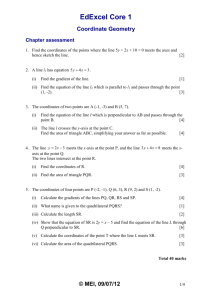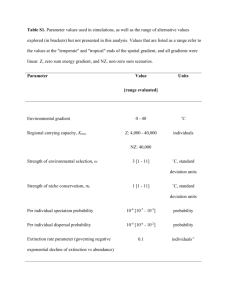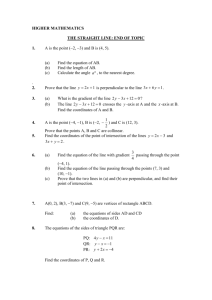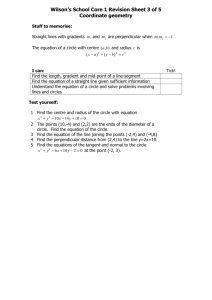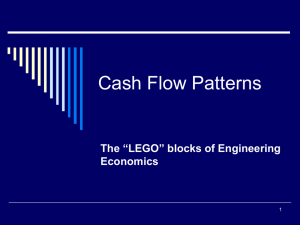Coordinate Geometry and Differentiation Test
advertisement
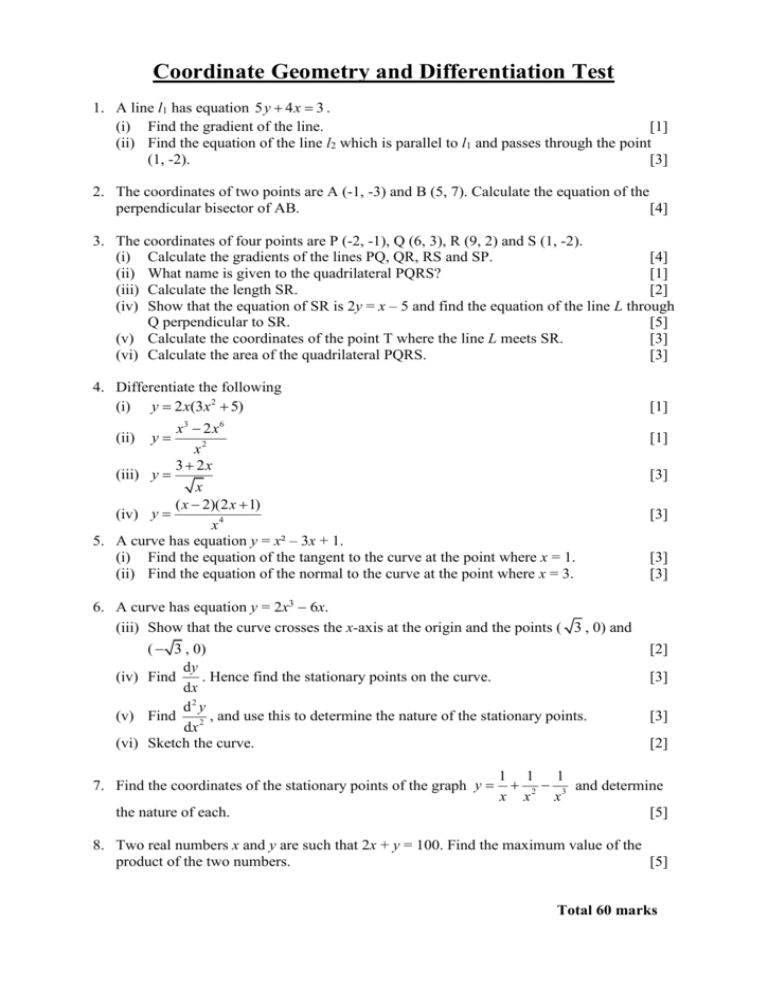
Coordinate Geometry and Differentiation Test 1. A line l1 has equation 5 y 4 x 3 . (i) Find the gradient of the line. [1] (ii) Find the equation of the line l2 which is parallel to l1 and passes through the point (1, -2). [3] 2. The coordinates of two points are A (-1, -3) and B (5, 7). Calculate the equation of the perpendicular bisector of AB. [4] 3. The coordinates of four points are P (-2, -1), Q (6, 3), R (9, 2) and S (1, -2). (i) Calculate the gradients of the lines PQ, QR, RS and SP. [4] (ii) What name is given to the quadrilateral PQRS? [1] (iii) Calculate the length SR. [2] (iv) Show that the equation of SR is 2y = x – 5 and find the equation of the line L through Q perpendicular to SR. [5] (v) Calculate the coordinates of the point T where the line L meets SR. [3] (vi) Calculate the area of the quadrilateral PQRS. [3] 4. Differentiate the following (i) y 2 x(3x 2 5) [1] x 2x x2 3 2x (iii) y x ( x 2)(2 x 1) (iv) y x4 5. A curve has equation y = x² – 3x + 1. (i) Find the equation of the tangent to the curve at the point where x = 1. (ii) Find the equation of the normal to the curve at the point where x = 3. (ii) y 3 6 [1] [3] [3] [3] [3] 6. A curve has equation y = 2x3 6x. (iii) Show that the curve crosses the x-axis at the origin and the points ( 3 , 0) and ( 3 , 0) dy (iv) Find . Hence find the stationary points on the curve. dx d2 y (v) Find , and use this to determine the nature of the stationary points. dx 2 (vi) Sketch the curve. 7. Find the coordinates of the stationary points of the graph y the nature of each. [2] [3] [3] [2] 1 1 1 and determine x x 2 x3 [5] 8. Two real numbers x and y are such that 2x + y = 100. Find the maximum value of the product of the two numbers. [5] Total 60 marks Solutions 1. (i) 5 y 4x 3 . 5 y 4 x 3 y 54 x 53 Gradient of line = 54 (ii) l2 is parallel to l1, so it has gradient 54 . Equation of line is y ( 2) 54 ( x 1) 5( y 2) 4( x 1) 5 y 10 4 x 4 5 y 4x 6 0 y 1 y 2 3 7 10 5 x 1 x 2 1 5 6 3 3 Gradient of line perpendicular to AB . 5 1 5 3 7 The line passes through the midpoint of AB , (2, 2) 2 2 Equation of line is y 2 53 ( x 5 ) 5( y 2) 3( x 2) 5 y 10 3 x 6 5 y 3 x 16 y 1 y 2 1 3 4 1 (i) Gradient of PQ x 1 x 2 2 6 8 2 y1 y2 3 2 1 1 Gradient of QR x 1 x 2 6 9 3 3 y 1 y 2 2 ( 2) 4 1 Gradient of RS x1 x2 9 1 8 2 y 1 y 2 2 ( 1) 1 1 Gradient of SP x1 x2 1 ( 2) 3 3 (ii) PQ is parallel to RS, and QR is parallel to SP, so the quadrilateral is a parallelogram. 2. Gradient of AB 3. (iii) SR ( 9 1)2 (2 ( 2))2 64 16 80 (iv) From (i), gradient of SR 21 Equation of SR is y ( 2) 21 ( x 1) 2( y 2) x 1 2y 4 x 1 2y x 5 Line perpendicular to SR has gradient -2 Line L has gradient -2 and goes through (6, 3) Equation of L is y 3 2( x 6) y 3 2 x 12 y 2 x 15 (v) Equation of L is y 15 2 x Substituting into equation of SR gives 2(15 2 x ) x 5 30 4 x x 5 35 5 x x7 y 15 2 7 1 When x = 7, Coordinates of T are (7, 1) (vi) L Q (6, 3) R (9, 2) T (7, 1) P (-2, -1) S (1, -2) Length QT ( 7 6)2 (1 3)2 1 4 5 Area of parallelogram SR QT 80 5 4. (i) 16 5 5 4 5 20 2 y 2 x(3 x 5 ) 6 x 3 10 x dy dx (ii) y dy dx (iii) y dy dx (iv) y dy dx 18 x 2 10 x3 2x6 x 2x4 2 x 1 8x3 3 2x x 3x 2 2 x 2 1 1 23 x 2 x 2 3 1 ( x 2)(2 x 1) x 4 2 x 2 3 x 3 2 x 4 4 x 3 9 x 4 8 x 5 5. (i) (ii) y x 2 3x 1 dy 2x 3 dx When x = 1, gradient 2 1 2 1 When x = 1, y 1 2 3 1 1 The tangent has gradient -1 and passes through (1, -1) Equation of tangent is y ( 1) 1( x 1) y 1 x 1 y x When x = 3 , gradient of tangent is 2 3 3 3 Gradient of normal 31 When x = 3, y 3 2 3 3 1 1 Normal has gradient 31 and passes through (3, 1) Equation of normal is y 1 31 ( x 3) 3( y 1) ( x 3) 3y 3 x 3 3y x 6 6. (i) y 2 x 3 6x When y = 0, 2 x 3 6 x 0 x 3 3x 0 x( x 2 3) 0 x 0 or x 2 3 x 3 So the graph cuts the x-axis at the origin and at the points (ii) 3 ,0 . dy 6x 2 6 dx At stationary points, 6 x 2 6 0 x2 1 0 ( x 1)( x 1) 0 x 1 or x 1 When x = 1, y 2 1 3 6 1 2 6 4 When x = -1, y 2 1 3 6 1 2 6 4 so the stationary points are (1, -4) and (1, 4). (iii) d2 y dx 2 12 x When x = 1, When x = -1, d2 y dx 2 d2 y dx 2 12 0 so (1, -4) is a minimum point. 12 0 so (-1, 4) is a maximum point. 3,0 and (iv) (-1, 4) 3 3 (1, -4) 1 7. y dy x 1 x 2 1 x3 x 1 x 2 x 3 x 2 2 x 3 3 x 4 dx Stationary points occur where dy dx 0 0 x 2 2 x 3 3 x 4 3 x 4 x 2 2 x 3 3 x2 2x x2 2x 3 0 ( x 3)( x 1) 0 x 1 or x 3 When x = 1, y 1 1 1 1 When x = -3, y 31 d2 y dx 2 1 9 5 271 27 2 x 3 6 x 4 12 x 5 When x 3 : d2 y 2 2( 3) 3 6( 3)4 12( 3) 5 2 2 2 27 27 814 dx d2 y 4 81 dx 5 As this is positive, 3, 27 is a local minimum. When x 1 : d2 y 2 dx d2 y 2(1)3 6(1)4 12(1)5 2 6 12 4 dx 2 As this is negative, (1,1) is a local maximum. 8. 2 x y 100 y 100 2 x Product of numbers P xy x(100 2 x ) 100 x 2 x 2 dP 100 4 x dx At stationary point, 100 4 x 0 x 25 P is a quadratic function, and the coefficient of x² is negative, so the stationary point must be a maximum point. When x = 25, y = 50, and P = 1250. The maximum value of the product of x and y is 1250.


